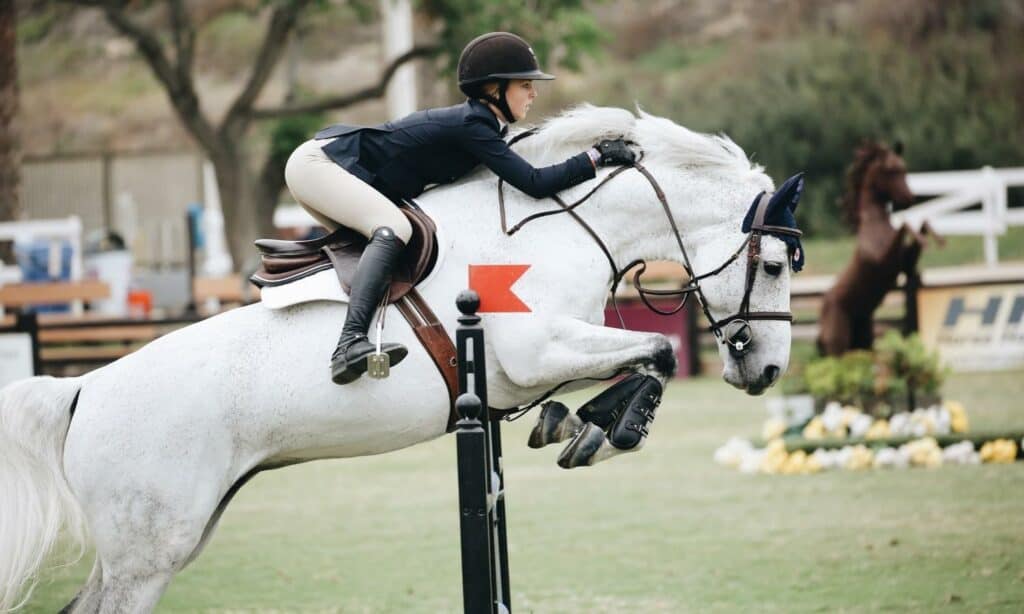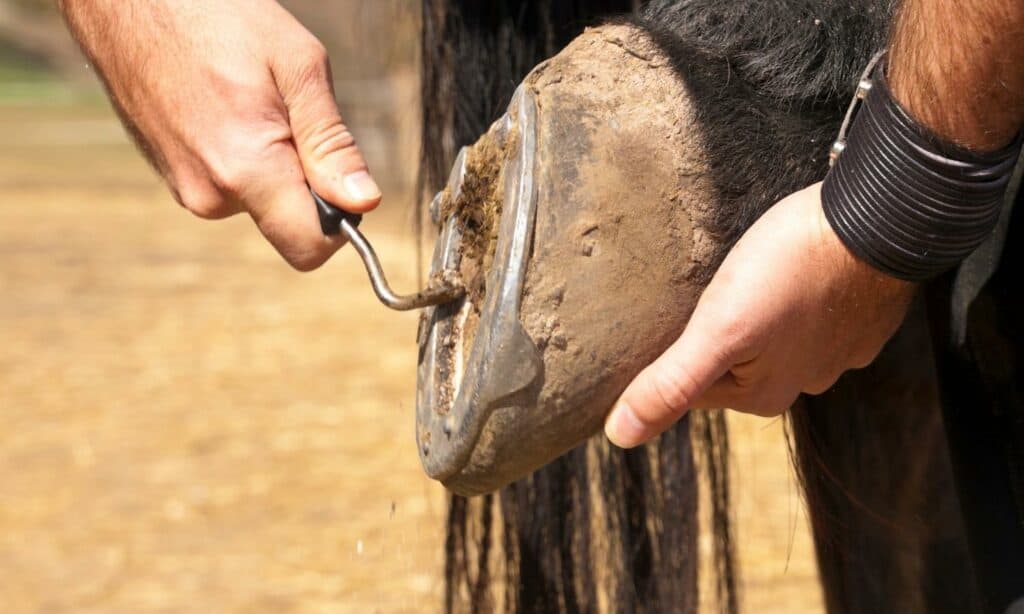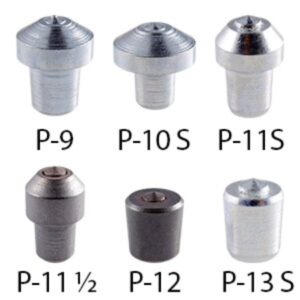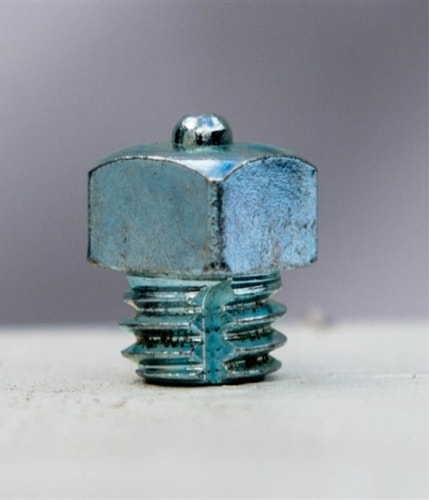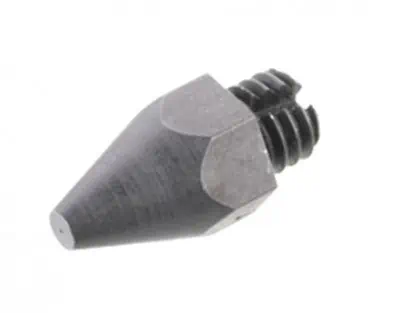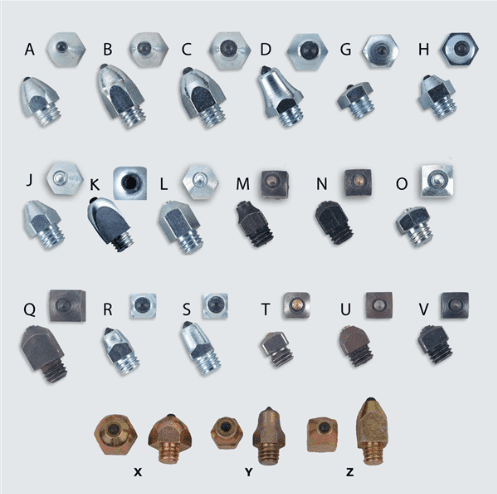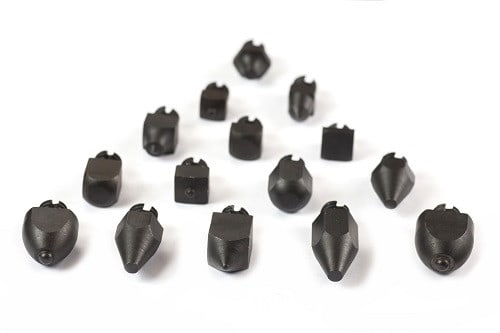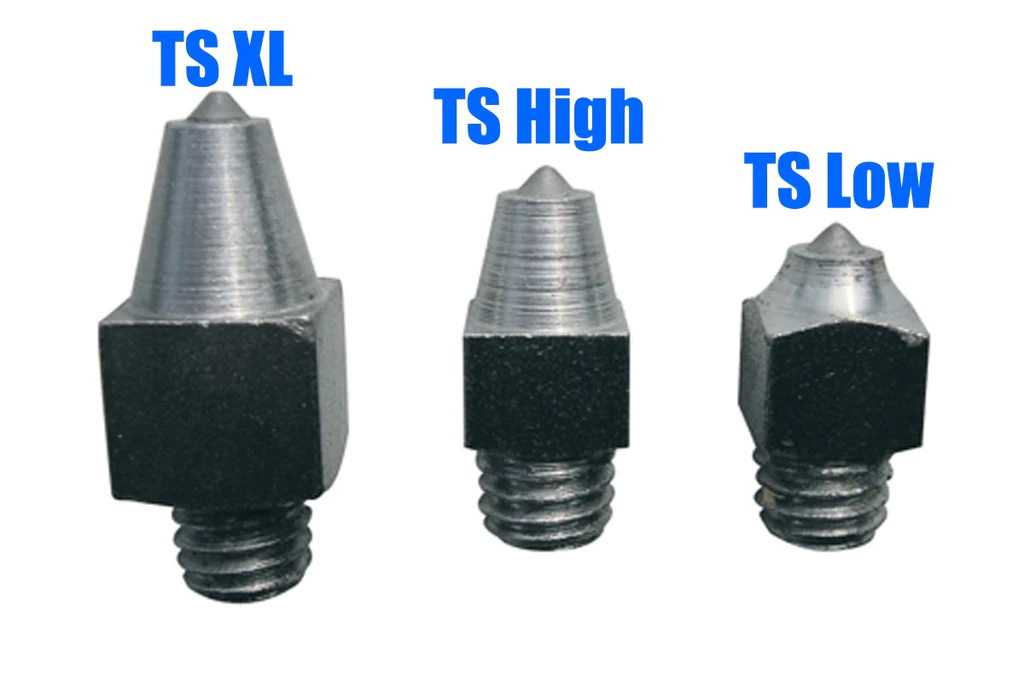- Can Horses Eat Watermelons - September 23, 2023
- How to Get a Horse to Trust You - September 21, 2023
- Best Horse Wormers for Spring Guide - August 10, 2023
- Bottom Line Up Front
- My Top Choices At A Glance
- What Are Horseshoe Studs?
- What Are The Different Types of Horseshoe Studs?
- Can Horseshoe Studs Hurt Horses?
- How Do You Use Horseshoe Studs?
- How I Choose Horseshoe Studs For My Horse
- The Best Horseshoe Studs on The Market
- Mustad P9 Road Studs
- Nunn Finer Small Square Road Stud
- SupaStud Grass/Hard Ground Stud
- Nunn Finer Grass Studs
- Supa Stud Mud Studs
- Stromsholm Square Jumping XL Studs
- Horseshoe Stud Safety Tips
- FAQs
- My Top Choice and Conclusion
- Resources
If you want to find the best horseshoe studs, you’ve come to the right place. I have many years of experience working with horses and know all about horseshoes and studs. Studs are a fantastic way to give your horse extra balance on boggy, slippery, or firm ground, and they come in many shapes and sizes.
So, if you want to know all about studs for horseshoes and how to find the best ones, I’ll tell you everything you need to know below.
Bottom Line Up Front
When it comes to horseshoe studs, I highly recommend the Small Road Studs from Nunn Finer. There are excellent studs for beginners and are perfect for hard surfaces. I love these studs because they’re ideal for all riding disciplines and daily use and are “the easiest ever stud” because they’re self-cleaning.
My Top Choices At A Glance
Before we get into the fine details about horseshoe studs, here’s a quick look at my top choices:
- The Nunn Finer Small Road Stud – These are my favorite ones on the market because they’re versatile and suitable for all riding disciplines on hard or rocky ground. They’re easy to put on and take off and are incredibly durable.
- Supa Studs Grass Studs – I love these studs because they’re made from hardened steel, which is lightweight, rust-resistant and more durable than traditional tungsten. These are the best studs for riding on hard, dry earth or when the surface is slippery after recent rainfall.
- Stromsholm Square XL Jumping Studs – These studs are one of the largest on the market and are ideal for big horses on soft, boggy ground. I like Stromsholm studs because they’re high-quality, made in the UK, and are a favored choice among professional horse riders.
What Are Horseshoe Studs?
Horseshoe studs are small steel studs which you attach to a horse’s shoe, usually at the heel, to give them extra balance and stability on slippery, boggy, or hard surfaces. Usually, they’re not more than an inch long and come in many styles to accommodate different terrains.
A horse must have shoes to wear studs, and you need to ask your farrier to make threaded stud holes in your horse’s shoes where you can screw the studs in. When you take the studs out, you must plug the holes with plug studs or cotton wool to protect them.
A horseshoe stud consists of three parts:
- The Thread – This is the part which screws into the shoe.
- The Barrel – This is the external part of the stud which connects with the ground. The barrel is different for each style of stud.
- The Core – The stud core is usually made from robust tungsten, which is durable and absorbs impacts.
How Do They Benefit A Horse?
The main benefit of horseshoe studs is they can boost a horse’s confidence and performance when they work on irregular or slippery surfaces. Horses can lose their confidence if they slip or lose their footing, and studs are an excellent way to make them more sure-footed.
You can use horseshoe studs in most riding disciplines – each stud has a unique style to help with different riding conditions. Pointy studs are ideal for hard and surface slippery ground, while dome, bullet-shaped, and square ones are better for soft surfaces. Studs are particularly beneficial on hind feet for extra grip and takeoff when jumping.
What Are The Different Types of Horseshoe Studs?
Diving into the world of horseshoe studs can be overwhelming because there are so many different ones on the market. You shouldn’t just buy any old studs for your horse – to make the correct choice – you must understand the different types and their functions.
To give you a clear idea about horseshoe studs, here’s a quick overview of the most common ones:
- Sleeper or Blanks – These are the smallest studs which stay in the shoe to protect the stud hole and provide the minimum amount of traction.
- Road Nails – Road nails aren’t a stud as such – they are horseshoe nails with a tungsten carbide pin inside, which protrudes slightly from the end. Only your farrier can put road nails on a horse – they don’t screw into the shoe. Road nails are ideal if you ride on the road a lot because they won’t wear down and become slippery like standard horseshoe nails.
- Road Studs – Road studs are small, usually square or hexagon and sometimes domed in the center. They are also known as flat studs and are ideal for providing extra traction on hard surfaces such as asphalt. They are also suitable for routine workouts on a grass paddock and are popular with riders who frequently use the road or firm trails.
- Mud Studs – Mud studs are thick and sizable to give a good grip in boggy, muddy conditions. They are domed, square or bullet shaped and anchor into soft ground to prevent horses from slipping.
- Grass Studs – Grass studs are long, narrow and pointed to penetrate hard, dry earth and are also good in sand. Most owners don’t use these on the outside of the foot, because they’re sharp and can damage the opposing leg if the horse brushes against it.
- Hybrid Studs – Some manufacturers offer hybrid studs that combine different stud designs, which you can use in various conditions and riding disciplines.
Can Horseshoe Studs Hurt Horses?
If you don’t use them correctly, horseshoe studs can injure your horse. You must choose the correct ones for your needs because poorly fitting ones will do more harm than good. A horse’s hooves and legs absorb shock, and when you add studs, you prevent normal function.
Horses naturally have a slip and some give in their hooves when they land. Using the wrong studs can interfere with your horse’s natural movement and cause jarring and even vertical fractures. They can also cause increased strain on tendons, especially large studs, and your horse might feel sore if they wear them too long.
If you’ve never used studs before, get advice from your farrier, vet, or an experienced horse owner at your barn to help you select the best ones. Also, horses can injure themselves with their studs, so use protective brushing boots or a stud girth, especially if they wear pointed studs.
How Do You Use Horseshoe Studs?
If you want to put horseshoe studs on your horse, you need a few tools to help you. I like to use a horseshoe stud kit which contains everything I need to fit and maintain my studs. A horseshoe stud kit typically contains:
- A variety of different studs
- A stud tap – for cleaning the horseshoe holes
- A stud spanner
- Stud plugs – rubber or cotton
- A magnetic bowl or wristband for the studs
- A horseshoe nail or other small pointy item to remove the plugs
- Rag or sponge for cleaning the studs
- Stud cleaner or lubricant like WD-40 makes them last longer.
To fit studs – remove the stud plug from the shoe and clean the hole with a brush or cleaning tool. Next, screw in the stud by hand, ensure the thread is aligned, or you might damage it, and then tighten it with a stud wrench. Remove studs as soon as you finish riding, and plug the hole back up. Clean your studs after use and store them safely.
How I Choose Horseshoe Studs For My Horse
The first thing I consider when I choose horseshoe studs is the type of stud I need for my riding discipline and the terrain I mostly ride on. Next, I assess what size studs I need and how many. Remember, using the wrong stud can injure your horse, so you must choose the correct one.
To help you find the ideal studs for your horse, we’ll take a closer look at the vital things to consider before you buy them.
#1 – The Type
I choose the stud type depending on my riding discipline and the terrain I usually ride on. That said, you can’t anticipate the weather and ground conditions, so it’s good to have a selection of studs for every eventuality.
I choose large studs for dressage riding and other disciplines where there are lots of tight turns – and I select smaller studs if I’m working on the straight. I pick pointed studs for riding on hard ground or square, domed or bullet-shaped studs for soft ground. If I plan on doing a lot of trail riding or road work, I choose small road studs for extra traction.
If you live in a place with lots of rain and the ground is usually boggy, it’s best to have more bullet and domed-shaped studs in your collection. If you live in a hot, dry climate and the earth is usually hard going, it’s better to have more pointed grass studs in your kit.
#2 – The Size
When it comes to stud size, the general rule is that the softer the surface – the larger the stud you need. The studs must be the same size on each shoe, but as you become more experienced riding in them, you can experiment with larger studs on the hind shoes.
I always choose the smallest studs appropriate for the job at hand – and I use smaller studs on horses with a light tread and bigger ones for horses who dig their feet firmly into the ground. You should never over-stud a horse – use small studs on light horses and ponies and larger ones on taller, heavier horses.
You might have to try different sizes before you find one that works for your horse. If it’s your first time using studs, start with road studs, the smallest ones, and work your way up, so you and your horse can get used to them.
#3 – The Quantity
It’s always good to buy more studs than you need because they always go missing no matter how careful you are with them. Sometimes the thread can break too, so it’s good to have backup studs.
At a minimum, you need four studs for your horse, two for each back foot, and the maximum a horse wears is usually eight. Professional competition riders may use up to six per foot, but this isn’t advisable for your average horse.
If you’re starting out, don’t buy large quantities of studs because your horse might not take to them. You should buy one set plus a set of backups to try them out. If you compete and use studs a lot, it’s worth investing in larger quantities and having a variety of studs for different terrains with plenty of backups.
#4 – The Material
Horseshoe studs must be tough and durable – they take a lot of impact, so they are usually steel. Most studs have a strong tungsten core and a steel outer, but you can also find studs made from hardened steel, which is more lightweight and durable than tungsten.
#5 – Buying Info
When you buy horseshoe studs, make sure you use an official equestrian website and that they have a returns policy in place in case the studs aren’t suitable. From my research, I found a greater selection of studs on the individual manufacturer’s website – the major online tack shops only had three of four types of studs available.
The leading horseshoe stud brands in the USA are Supa Studs and Nunn Finer, so these are good places to start looking for suitable studs. You can also find studs in your local tack shop, which is good because you can physically inspect them before buying them, but often they only have a limited supply for you to choose from.
The Best Horseshoe Studs on The Market
Now that you know what to look for in a horseshoe stud, you must pick the correct ones for your needs. There are a lot of horseshoe studs on the market, so to save you time trawling through the internet, below, I’ll tell you my top choices in horseshoe studs.
I chose these studs because they’re from trusted equestrian brands with a solid reputation for producing high-quality products. They are all backed by many positive customer reviews and endorsed by professional horse riders. I also selected them for their durability, ease of use and because they’re the best in their categories for the job.
#1 – The Best Road Studs
Mustad P9 Road Studs
The Mustad P9 Road studs are ideal for horses who work on hard surfaces. They are drive-in studs – you must gently hammer them into the shoe, and they are safe to leave in because they are small, smooth, and won’t injure your horse or their field mates if they kick out.
The studs are 14 x 7 mm and have a welded tungsten carbide insert. They’re steel, and the stud is brazed onto the barrel, which makes them super durable. I love these studs because they’re well-made, long-lasting, and are perfect if you need a bit of extra traction on roads, snow, mud and ice.
Pros:
- These studs are highly durable on rocky terrain.
- They are small and smooth, and you can leave them in the shoe.
Cons:
- You must hammer the studs in rather than screw them, so they’re better for long-term use.
Nunn Finer Small Square Road Stud
Nunn Finer has an outstanding reputation in horseshoe studs, and these road studs have a unique self-starting channel that cleans out the stud holes as you put them in. The result is that you can put them on and take them off effortlessly.
I love the Nunn Finer small road plug because it’s perfect for all riding disciplines and everyday use. They’re made from high-quality steel and are tough and durable – and are ideal for hard and rocky terrain.
Pros:
- They’re self-cleaning.
Cons:
- They offer minimum traction.
#2 – The Best Grass Studs
SupaStud Grass/Hard Ground Stud
Supa Studs are a British equestrian brand, and its products are a favorite among professional riders. The Supa Stud grass studs are made from hardened steel, which is stronger and lighter than tungsten and has a ⅜-inch thread.
I love Supa Stud grass studs because they have 15 types to choose from – and they’re rust-resistant and self-cleaning. These studs are incredibly durable and are ideal for riding on hard, dry grass or if the surface is slippery after rain.
Pros:
- They’re self-cleaning.
- They’re the top choice among professionals.
Cons:
- They are sharp, so you must put boots on your horse when you use them
Nunn Finer Grass Studs
Nunn Finer grass studs are ideal for riding on grass and hard, dry terrain. They’re made from high-quality, durable steel and are ⅜ wide and ⅞ deep (not including the screw).
I love these studs because they’re solid and square with a small spike – so they can penetrate most surfaces. Nunn Finer is one of my favorite horseshoe stud brands because their products are well-made and durable.
Pros:
- They’re ideal for hard, dry ground.
Cons:
- They are sharp, so your horse must use boots when you use them.
#3 – The Best Mud Studs
Supa Stud Mud Studs
The Supa Stud mud studs are outstanding when it comes to quality and durability. They’re made in the UK and have won awards for their innovative self-cleaning design. Supa Studs are made from hardened steel, which is rust-resistant, lightweight, and more durable than tungsten.
I love these mud studs because they come in three styles – bullet, dome and maxi dome. They are ideal for anchoring your horse in the ground in soft, muddy conditions.
Pros:
- They’re self-cleaning.
- They’re very durable.
Cons:
- You can’t use them on hard ground.
Stromsholm Square Jumping XL Studs
Stromsholm is a British brand specializing in hoof care, and they produce shoes and studs for The Queen of England and her horses. Stromsholm is a top-quality brand and a favorite among professional riders.
I like the Stromsholm square jumping studs because they are one of the largest on the market, and the square jumping studs will prevent your horse from slipping in boggy conditions. The XL jumping studs are best suited to large horses who need extra support on the hind feet.
Pros:
- They’re high quality and super durable.
Cons:
- They’re not suitable for small horses or ponies.
Horseshoe Stud Safety Tips
Horseshoe Studs can enhance your performance in any riding discipline, but if you use them incorrectly, they can harm your horse. To get the best results and to minimize the chance of injury from your studs, take look at these top safety tips:
- Put the studs in just before you ride and remove them as soon as you finish – don’t leave your horse standing around in them.
- Never turn a horse out in studs – they might injure themselves and their herd mates.
- Never put your horse in a horsebox or trailer with studs on – they will damage the floor and may injure themselves.
- Use brushing boots to protect your horse’s legs from the studs – especially if you use pointed ones.
- Only use studs when you need them.
- Never use front studs without hind ones, and be cautious when you use studs on the front legs because they take the most weight and impact.
- Always use blunt studs on the inside of the foot.
- Always use the smallest studs necessary.
- Try new studs out in practice before you use them in a show.
FAQs
Answer: Use small road studs to give your horse more traction if you ride on hard ground, such as asphalt or rocky trails. If you ride on hard grass or hard grass with a slippery surface after rainfall, you should use grass studs.
Grass studs are long and narrow with a pointed tip which can penetrate hard, dry earth. You should avoid using grass studs on the inner hoof because they can catch the horse’s opposite leg and injure it. As a precaution, you should always use brushing boots with pointed studs.
Answer: You should use purpose-made horseshoe studs for horses and choose the style according to your riding discipline and the type of ground you usually ride on. If you ride on the road or rocky trails, use road studs. If you ride on hard, dry grass, use grass studs. If you live in a place with lots of rain and soft ground, you should use mud studs. If you take part in riding disciplines that require tight turns, such as jumping and dressage, you should use larger studs than if you perform on the straight.
My Top Choice and Conclusion
When it comes to horseshoe studs, I highly recommend the Nunn Finer Small Road Studs. These are durable, high-quality studs from one of America’s leading brands in the hoof care industry.
I love these studs because they’re small and versatile – you can use them in most riding disciplines when the going is hard. The Nunn Finer Small Road Studs are fantastic for beginners and are ideal for riding on hard surfaces such as asphalt and rocky trails.
Horseshoe studs are a fantastic way to give your horse confidence and improve their grip when they work on hard, soft or slippery ground. Studs come in many different shapes and sizes, and it’s good to have a selection of different ones to suit various riding conditions.
The main thing to remember with horseshoe studs is to choose the right ones for your needs. If it’s your first time using studs, start with the smallest size and work your way up and don’t be afraid to seek advice from your vet, farrier or a more experienced horse owner at your barn.
Resources
- Bishop, Wash. “Get a Grip with Horse Shoe Studs.” Practical Horseman, 4 Oct. 2017, practicalhorsemanmag.com/health-archive/studs_100406-11384.
- David. “Which Studs Should I Use?” British Eventing Life, 30 Mar. 2021, www.britisheventinglife.com/which-studs-should-i-use.
- Roome, Pippa. “When Should You Use Studs on Your Horse?” Horse & Hound, 25 May 2022, www.horseandhound.co.uk/features/when-should-you-use-studs-on-your-horse-482732.
- “Which Studs When | SupaStuds.” SupaStuds Ltd., www.supastuds.com/About/Which_Studs_When.html. Accessed 25 Aug. 2022.


